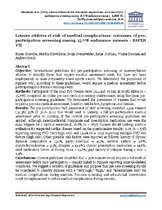| dc.description.abstract | OBJECTIVE: International guidelines for pre-participation screening of masters/leisure athletes to identify those that require medical assessment exist, but have not been implemented in mass-community based sports events. We determined the prevalence of runners who, according to these guidelines, would require a medical assessment before participating in a distance running event.
METHODS: Participants of the 2012 Two Oceans races (21.1 and 56 km) in South Africa (n = 15,778) completed an online pre-race medical screening questionnaire using European pre-participation screening guidelines. We determined the prevalence of runners that would require a pre-race medical assessment, based on risk factors, symptoms, and disease.
RESULTS: The pre-participation “self assessment of risk” screening identified 4,941 runners (31.3%; 95% CI 30.6–32.0) that would need to undergo a full pre-participation medical assessment prior to running, if the current pre-participation screening guidelines are applied. Although musculoskeletal complaints and prescription medication use were the main triggers for a medical assessment, 16.8% (n = 2657) runners should undergo medical evaluation for suspected cardiac disease based on the questionnaire results: 3.4% (n = 538) reporting existing CVD (very high risk) and 13.4% (n = 2119) reporting multiple CVD risk factors (high risk). Other possible risk factors were reported as follows: history of chronic diseases (respiratory = 13.1%, gastro-intestinal = 4.3%, nervous system = 3.8%, metabolic/endocrine = 3.5%, allergies = 13.9%); chronic prescription medication = 14.8%, used medication before or during races = 15.6%; past history of collapse during a race = 1.4%.
CONCLUSIONS: Current guidelines identified that > 30% runners would require a full medical assessment before race participation – mainly linked to runners reporting musculoskeletal conditions. We suggest a revision of guidelines and propose that pre-race screening should be considered to identify runners with a “very high,” “high,” and “intermediate risk” for medical complications during exercise. Pre-race screening and educational intervention could be implemented to reduce medical complications during exercise. | en_US |

